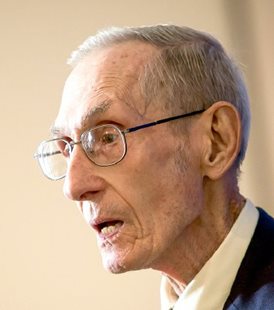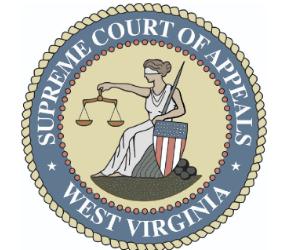So taught retired WVU journalism professor Paul Atkins, now 91
By Jim Bissett
The Dominion Post

Paul Atkins
MORGANTOWN, W.Va. — Ed Buckbee never forgot how the wiry little guy with the big round glasses shot out of The Daily Athenaeum newsroom like a rocket that day.
On that October day in 1957, all of America — which included a handful of WVU journalism students working for their school paper in Morgantown — found out that the Soviet Union had
just conquered outer space.
The first interstellar grid of it, anyway.
A satellite named Sputnik had successfully launched, and while the humble craft didn’t do much but emit radio beeps while circling the Earth in low orbit, the USSR still got there before the U.S. did.
And that meant that Sputnik’s real payload was Cold War angst: Can they shoot ray guns at
us from up there? Can they spy on us from up there?
Buckbee, a journalism major from Romney who wrote for the DA , would see the space race up close for himself just five years later.
That’s when he embarked on a four-decade career in public affairs for NASA that took in everything from the “Right Stuff ” years of the Mercury and Gemini days to the International Space Station, with its American astronauts and Russian cosmonauts coexisting past the surly bonds of Earth.
On that Sputnik day back in tail fin ’57, though, he was just trying to figure what in the world, or out of this world, was going on.
The paper’s UPI teletype machine, a cumbersome beast that required its own closet-sized space off the newsroom, clanged 10 bells and began chittering copy as it delivered the news.
“Ten bells and you knew you were in for it,” Buckbee recalled in a profile in this newspaper in the early 2000s.
“Ten bells meant the president was dead, or we were at war, or something,” he said. “None of us even knew how to pronounce ‘Sputnik.’ Paul remembered this professor on campus who spoke Russian, so he took off after him.”
That would be Paul Atkins — he of the slight frame and circular lenses — the DA ’s faculty adviser at the time.
Might you be wondering, the 91-year-old still lives in Morgantown, and is still writing his story.
Mr. A’s way
Atkins, a McDowell County native who came to WVU after a few years on the police and city government beats at The Richmond Dispatch in Virginia, knew that any story, no matter how big or small, carries a host of angles just waiting to be vectored into.
Besides, the adviser told his students that day, who ’s to say a Russian-speaking academic in Morgantown wouldn’t have an insight or two on Soviet psyche in Moscow?
Heck, he said, there might even be an exclusive kernel to be uncovered.
That meant The Daily Athenaeum could own a piece of the biggest post-World War II story out there.
Atkins gave an appreciative chuckle at Buckbee’s account.
Honestly, he said, he can’t quite remember if he was able to round up the Russian-talker that day. WVU-time, he said, is all relative.
“It’s amazing how many people you can’t find after 4 p.m.,” he said, drolly.
He is heartened, however, that one of those fledgling reporters from nearly 60 years ago can still find the core of his on-the-fly lesson that day.
“I’d try to make them proud of the paper,” Atkins said. “I thought we put out a doggoned good product.”
Atkins spent 33 years at WVU’s school of journalism, the newly named Reed College of Media. Twelve of those years were spent in the DA newsroom. He retired in 1986, but the educator
who is still known as “Mr. A” manages to remain synonymous with the doings of both places, because of accounts like the above.
Reporters-to-be in his newsroom and in his classroom learned early on that stories can’t subside on facts alone: You have to have people in there, too. Real people, real voices.
“That’s how Paul worked it when he was a reporter,” Buckbee said. “That’s how he taught us.”
“You have to get the story, ” Atkins said, “but then you have to tell it.”
When Atkins was a reporter, telling the story meant crafting sentences and paragraphs that sang, or at least weren’t afraid to get their hands dirty, from one manual typewriter-carriage
return to the next.
County fairs, cops, church socials, council meetings and more cops were just another day at the office.
And never mind that he would have gleefully struck the above “day at the office” chestnut with that famous red pen of his, if given the chance.
Omnipresent editor
Don’t get Lee Maynard started on that red pen.
Maynard was a one-time pharmacy major from the Wayne County town of Crum who dropped out, joined the Army and then dropped back in after his hitch to earn a journalism degree in 1961.
After that, he worked in public relations, edited a couple of corporate magazines and was a college president, even, before he got a job authoring those “Drama in Real Life” features
for Reader ’s Digest. He did that for 20 years.
While all that was going on, he also managed to write a certain scatological novel about his teenage years in his hometown, titled simply, “Crum.”In it, you won’t find any pastoral mountain memories of growing up joyfully in Amost Heaven.
Nope —this one is more like, say, the Mayberry of Andy Griffith, chopped and pureed with Seth MacFarlane’s sense of humor.
“A lot of it is made-up,” Maynard said. “Nobody taught me how to write fiction, but I’ll tell you what: Paul Atkins sure taught me how to be a journalist.”
Atkins was his first editor, which comes back around to the image of that red pen that still hovers around the reporter quadrant of Maynard’s brain.
“I used to dread walking in that newsroom,” he said, with good-natured gruffness, at the memory.
“It’d be 9 in the morning,” Maynard continued, “and Paul would already have that day’s edition marked up with that red pen. There’d be red everywhere. He could work copy faster than anybody I knew.”
“It wasn’t all bad,” Atkins said. “I’d circle the mistakes, but I’d mark the good stuff too. I wanted them to learn.”
What Mr. A’s students really learned, Maynard said, was that their faculty adviser actually lived his lesson plan.
Such as when the call from administration would come over asking the paper (that is, its faculty adviser) to downplay a story or kill it all together, Maynard remembered.
“It’d be something like football players getting in trouble with alcohol, but Paul never blinked. We always reported it. The guy had a sense of ethics that was unbreakable. When I was doing straight journalism for Reader ’s Digest, it was like I had Paul looking over my shoulder.”
Streaming history
These days, Atkins looks back with good memories at the school that gave his reporter-voice a nuance he never knew it had.
The digital direction that journalism instruction at WVU is now taking was “inevitable, ” he said, but he also sees an easy transition. He likes the way the Reed College of Media is writing its next big story.
But journalism, in general? Well, he can understand the 24-hour news cycle, he said, but he’ll never fathom why many media outlets now report it first, confirm it second, and run the correction third.
“I always told my students, ‘The first thing is accuracy — not getting it first.’ ”
Same for journalists who embellish their wartime reporting, only to get snagged in the lie later
by the people who were also there.
“You pay for the sins one way or the other,” he said. “It’s unfortunate, because it’s your name and your credibility.”
He’s quick to use the school ’s new name, but he also likes that it’s still 1957, in that fledgling journalists are still taught to focus on the first draft of history that is the act of news-gathering.
He likes that the flight path has stayed the same, even if the delivery system is changing.
“When I was there,” he said, “I thought we had the best journalism school in the county.
“And I still do.”
To read more from The Dominion Post, subscribe here.






